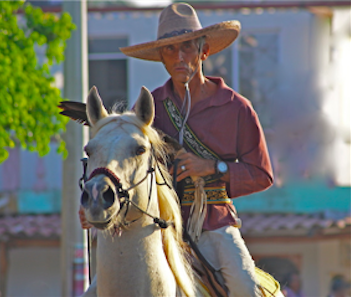
La conquista del Colorado.
(Image by (From Wikimedia) Augusto Ferrer-Dalmau Nieto, Author: Augusto Ferrer-Dalmau Nieto) Details Source DMCA
Often in life, we find more difficulty in getting motivated to implement a healthy practice than exists in the practice itself. Similarly, it is relatively easy for a professor to start decolonizing coursework in any academic discipline and more challenging to make and sustain the commitment to do so. I begin here describing the more straightforward task, offering three ways to start immediately. I end with a brief explanation of why we talk about decolonizing in higher education more than we do.
So what does decolonizing curriculum and instruction involve?
(1)A Focus on "Actual Decolonization"
First, faculty and students must realize and address "actual" decolonization before and throughout talking about other vitally essential and integral repercussions of it. The "actual" one relates to the original and continuing colonization of the Americas and the decimation and oppression of Indigenous people by the European invaders. The second relates to the many current social/ecological injustices, colonial practices that support them, and deterrents to the pursuit of happiness that stem from this actual event and the ongoing manifestations of it. To focus on this second form of colonization without continuing to rectify the first is full of dangers to both.
To engage with the topic of "actual decolonization" calls for engaging students in truth and reconciliation discussions about historical, contemporary, and future realities. It is about the wrongness of how we have treated Indigenous nations, communities, and individuals, and what we can do to mitigate it. It includes awareness of the resilience, courage, and leadership of Indigenous people. It requires studies that focus on authentic sovereignty and restoration of as many stolen rights as possible.
It may be best to put a course dedicated to studying this actual colonization into the first term requirements for all students. Whether it is or isn't, however, this focus must remain part of all subsequent courses to some significant degree. Redundancy is fine and even necessary. Each session can promote a return of Indigenous sovereignty and rights via the subject area's unique lens. For example, if the course is Critical Reading and Writing, having students recognize "anti-Indianism" in literature would be one way to expose current laws, policies, and attitudes that stifle sovereignty, truth, and reconciliation. If the course is Foundations of Inquiry, using contested positions about the treatment of American Indians to develop the ability to judge the strength of arguments, would further pro-sovereignty support. If Leadership and Praxis, a brief study of Indigenous activism would be exemplary for students. For Organizational Theory, using the Indian Reorganization act to demonstrate awareness of the complex issues faced by managers in the area of ethics and social responsibility would be perfect. You get the idea.
(2) Identifying Colonial Hegemony in Each Course
Indigenizing a way of thinking or a practice requires recognizing problems with current thinking and practices. We cannot change that which we do not acknowledge as needing change. Together with students, faculty can discover what colonial assumptions are foundational and ongoing in the domain of the subject area. To get a sense of what this looks like, see Teaching Truly: A Curriculum to Indigenize Mainstream Education. It exposes hegemonic (colonizing) assumptions in English Language Arts, United States History, Mathematics, Economics, Science and Geography and shows how to replace it with a pre-colonized or Indigenous perspective and practice. Other references are easily found by Googling your course topic with the question "How is (fill in the course topic) influenced by colonized thinking, corporatism, or American hegemony?
A professor does not have to master this material in advance nor serve it on a plate to students. Such expertise or didactic approaches to teaching usually reflect colonized thinking. Indigenous learning is largely experiential. Of course, a great advantage exists in having an Indigenous teacher, especially one who was raised according to traditional values and is fluent in the traditional language. Even such individuals are likely to carry some colonized beliefs via their Western education. In any case, a traditionalist with a stronghold on original wisdom would mostly "teach" via guiding student research, observation, and praxis. Like any field of study, new knowledge and interdisciplinary investigation can unveil important precepts of the generalized Indigenous worldview and of unique, place-based Indigenous knowledge. Ample literature exists to assist the process of decolonizing education, but ultimately it is deep reflection, dialogue, and real-life applications that make the seeds of knowledge grow.
An excellent way to start the search for hegemony is to see the chart below and talk with students about what parts of the course description or syllabus fall on one side or the other. Then study some basic ideas that are typically taught in the course the same way. What hidden colonial message operates? What harm does it do in the world? How can it be modified? With the faculty and the student joining in this process, equal footing during the discovery can bring forth the learning about the truly useful parts of the topic while exposing those that do not help prevent the world's problems. It becomes an exciting adventure.
If a non-Indigenous instructor still feels nervous or unprepared to do this work, see my peer-reviewed article online from UBC's Critical Education journal titled "The Indigenization Controversy." It may help with rethinking this common apprehension or excuse for not moving forward with decolonizing curricula.
(Note: You can view every article as one long page if you sign up as an Advocate Member, or higher).





